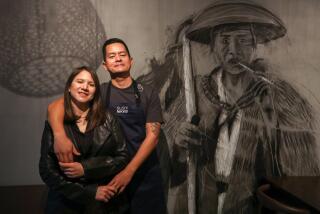Low-Chill Kiwi Adapts to Southland Climate
- Share via
Perhaps no exotic fruit in recent years has experienced such a meteoroic rise in popularity as the kiwi--from a New Zealand novelty to practically a food staple in many homes. And with good reason. Kiwi fruit not only taste good, they have twice as much Vitamin C as a lemon, they contain lots of potassium and almost no sodium.
During the 1980s many Southland gardeners tried to grow kiwi plants with mixed success. If they grew a low-chill variety, they probably experienced good results. However, if they planted many of the standard kiwi varieties (such as Hayward), their results were probably poor. In most areas of the Southland our climate is too mild for kiwis; we usually don’t have enough chilling temperatures to promote proper fruiting.
To learn more about kiwi plants I visited Roger Meyer, who along with his wife, Shirley, runs a small, custom nursery in Fountain Valley that specializes in kiwi plants.
Meyer says that the kiwi is indigenous to China’s Yangtze River Valley, where its vines climb high into forest trees. Also known as the Chinese gooseberry vine, it was introduced into New Zealand in 1906. There it became a common back yard plant for decades before anyone thought of growing kiwis commercially. Finally, in the 1960s, innovative marketers decided to share kiwi fruit with the rest of the world.
According to Meyer, the kiwi needs a lot of growing space. The vines resemble large, overgrown grape vines, and the fruit are produced in grape-like clusters. The vines need the support of a trellis, arbor or fence strong enough to hold the considerable weight of the fully grown vines.
Meyer says kiwi plants can be used successfully in many landscape situations. They make a marvelous patio cover. They have large, roundish leaves that are dark green on top and lighter underneath. The spectacular blossoms are large and cream colored with yellow interiors. The plants will provide cool shade during the warm months, yet allow the sun to shine through during the winter months when they lose their leaves.
Meyer says that to experience success with kiwis in most Southland climatic zones, you must plant a variety that does not require a high degree of winter chilling. The most popular low-chill variety is called Vincent. When local nurseries have kiwi plants in stock, Vincent is the one you are most likely to encounter. Meyer says Vincent is a reliable producer of good quality fruit.
To bring other low-chill varieties to Southern California, Meyer has personally collected kiwi plants from New Zealand and China and he tests them at his Orange County home nursery. He has recently imported kiwi plants from China that have bright orange, yellow or red flesh instead of the usual emerald green flesh.
His prize kiwi variety is called Elmwood. It produces fruit that are astonishingly large--three times the size of normal kiwis. Meyer says that the fruit is produced in prolific quantities and that the flavor and texture are “terrific.” In addition to Elmwood, Meyer has 14 other low-chill varieties. While he has plants of Elmwood for sale, for the other 14 varieties, Meyer sells only scion wood to be grafted onto other kiwi varieties.
No matter which kiwi variety one selects, Meyer says it is important to note that to get fruit, you need to plant a male plant along with the fruit-bearing female plant. Nurseries that carry named kiwi varieties will also have male plants.
Kiwi plants require a sunny growing area. They aren’t picky about soil type, but it absolutely must drain well.
Space kiwi vines 15 to 20 feet apart and plant them as deep as they were in their nursery containers. Add time-release fertilizer tablets at planting time.
Meyer notes that kiwi plants are definitely not candidates for a drought-tolerant garden--they need ample moisture. Except when the plants are dormant, they should receive regular, deep irrigations; the soil should be kept moist, but never soggy.
Fertilize the plants each spring and early summer with a fruit tree fertilizer. Water thoroughly after fertilizing.
According to Meyer, in the Southland the fruit of most kiwi varieties is ready to harvest after Nov. 1. Kiwi fruit does not usually ripen on the vine. The fruit is picked and allowed to ripen indoors for about a week before it is ready to eat.
Kiwi vines need to be pruned each January to get rid of old wood and to force new wood which contains next year’s blossoms. Meyer does a free kiwi pruning demonstration each January and may be contacted for details. In addition, some pruning books tell how to prune the plants.
As previously mentioned, Vincent is the most common kiwi variety that produces well in our area. Some local nurseries carry the plants and also male pollinating plants. Check with your local nursery. Exotica Rare Fruit Nursery in Vista, (619) 724-9093 and Tomlinson’s Nursery in Whittier, (310) 698-5221, regularly stock the Vincent variety.
If you want to try some of the more exotic kiwi varieties, such as the gigantic Elmwood variety, contact Roger Meyer. His Valley Vista Kiwi Nursery is located at his home. The address is 16531 Mt. Shelly Circle, Fountain Valley, CA 92708; phone (714) 839-0796. An appointment to visit the nursery may be made by calling Roger or Shirley Meyer on weekday evenings between 5 and 11 p.m.
More to Read
Sign up for The Wild
We’ll help you find the best places to hike, bike and run, as well as the perfect silent spots for meditation and yoga.
You may occasionally receive promotional content from the Los Angeles Times.






